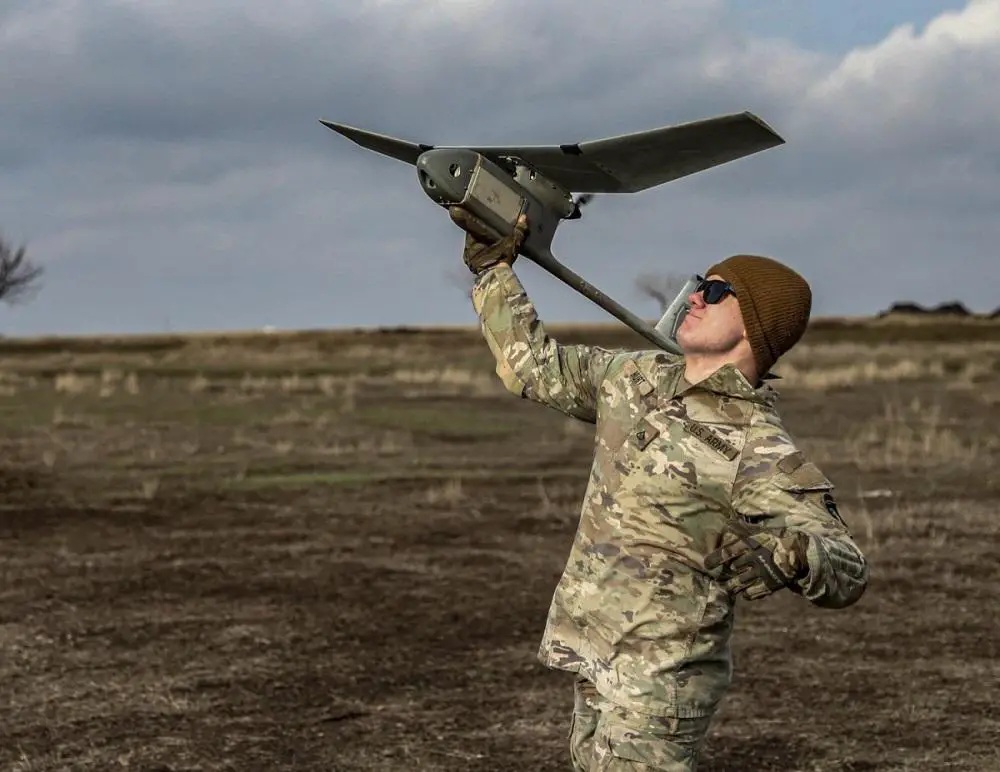U.S. Army Soldiers assigned to 1st Battalion, 26th Infantry Regiment, 2nd Brigade Combat Team, 101st Airborne Division (Air Assault), improved their skills on the newly updated unmanned aerial vehicle, RQ-11B, or “The Raven,” in Smardan, Romania, 16 Jan. 2023. With the recent upgrades made to the RQ-11B Raven Small Unmanned Aircraft System, referred to as The Raven, Krebs believes the task is made easier.The Raven system is the most widely deployed unmanned aircraft system in the world, ideal for low-altitude intelligence, surveillance and reconnaissance missions that depend on rapid deployment and pinpoint maneuverability. Even after being highly trained on this equipment Soldiers continue to further their knowledge with the help of the manufacturers themselves. One of the manufacturer’s representative was sent to further educate Soldiers on the recent upgrades made to the Raven.
“We’re here in Romania to assure, deter and reinforce our NATO allies. A Raven is a small unmanned aerial vehicle, a drone that has many different capabilities. It can fly out to 10 kilometers, and allows you to capture photographs and even video. One of the civilian contractors with AeroVironment, the manufacturer of the Raven, is here to help us learn more about its capabilities and show us how to use it more efficiently, and the capabilities that it has. Upgrading our technology will allow us to be more versatile in the upcoming conflicts,” said Pfc. Henry Krebs Parker, a scout with 1-26 Infantry Battalion, 2nd Brigade Combat Team 101st Airborne Division (Air Assault).
“Right now we’re practicing using a gimbal payload. We’re working towards our live-fire that’s upcoming where we’re going to use the Raven to identify and pull grids for call for fire on mechanized targets,” Sgt. David Meyer, a scout with 1-26 Infantry Battalion, 2nd Brigade Combat Team, 101st Airborne Division (Air Assault).

Technology is always ever-changing. It’s important for the U.S. Army to stay up with those changes. Lightweight and straightforward to operate, the Raven is rucksack portable and can be hand-launched for both day and night observation. The AeroVironment RQ-11 Raven has an optional stabilized gimbaled payload, and delivers real-time color and infrared imagery to the ground control and remote viewing stations. The Raven RQ-11B UAS is manufactured by AeroVironment. It was the winner of the US Army’s SUAV program in 2005, and went into Full-Rate Production (FRP) in 2006. U.S. Army going to use the Raven to identify and pull grids for call for fire on mechanized targets. Due to its advanced avionics, the Raven can be operated manually or programmed for autonomous navigation. The Raven’s purpose is to be used for reconnaissance missions, call-for-fire missions and to enhance the Soldiers’ capabilities – lowering the risks to the Soldier, reducing U.S. casualties, and improving the success rate of various missions.
The AeroVironment RQ-11 Raven is a small hand-launched remote-controlled unmanned aerial vehicle (or SUAV) developed for the United States military, but now adopted by the military forces of many other countries. The RQ-11 Raven was originally introduced as the FQM-151 in 1999, but in 2002 developed into its current form, resembling an enlarged FAI class F1C free flight model aircraft in general appearance. The craft is launched by hand and powered by a pusher configuration electric motor. The RQ-11B Raven UA weighs about 1.9 kg (4.2 lb), has a flight endurance of 60–90 minutes and an effective operational radius of approximately 10 km (6.2 miles). The RQ-11B Raven UA is launched by hand, thrown into the air like a free flight model airplane. The Raven lands itself by auto-piloting to a pre-defined landing point and then performing a 45° slope (1 foot down for every 1 foot forward) controlled “Autoland” descent. The UAS can provide day or night aerial intelligence, surveillance, target acquisition, and reconnaissance. The U.S. Army deploys the Raven at company-level.
















